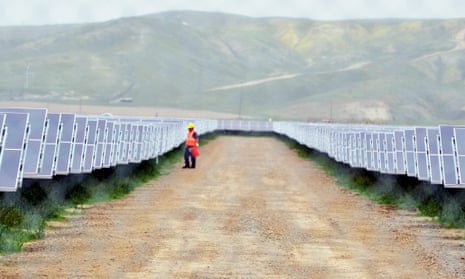When the World Wildlife Fund and World Resources Institute approached General Motors, along with 12 other companies, to collaborate on renewable energy, my first thought was: “We’re in.” Even though GM is already halfway to its public goal of using 125 megawatts of renewable energy by 2020, there are still major roadblocks along the way.
Working with these NGOs and other big corporate buyers, I thought, could help enable us to stop reinventing the wheel every time we try to buy more renewable energy. The opportunity was to frame up the needs and challenges for buyers, then provide solutions to make renewables more affordable and accessible for all companies, not just GM.
Together, the group developed the Corporate Renewable Energy Buyers’ Principles, a clear set of guidelines to help utilities, utility commissions and renewable energy providers understand how they can help make investments easier for companies and meet rising demand.
Demand is high. These 12 companies intend to acquire a combined total of 8.4m megawatt-hours of renewable energy per year. That’s equivalent to avoiding the greenhouse gas emissions of more than 1.2m passenger vehicles.
The goal is to view and unleash this demand more holistically, rather than having to create financing models and business forecasts on a project-by-project basis. This long-term, more systemic approach should help to make renewable energy projects more widely available.
There is good reason why companies should want to incorporate more renewable energy into their operations. Renewable energy presents a long-term strategic business opportunity to minimize risk and protect from rising electricity costs. However, most companies still struggle with the initial investment and long payback periods. Greater economies of scale and innovation in multiple areas can make renewable energy more affordable, and renewable energy buyers, utilities, developers and lenders all have a role to play.
Utilities, for example, can help address some challenges like long payback periods by buying some of the unused energy generated. Statewide renewable energy targets may help incentivize a utility to leverage capacity in innovative ways such as this. For example, if a warehouse that uses rooftop solar panels to power part of its operations is only open Monday through Friday, utilities should be able to – and want to – buy the energy produced on Saturday and Sunday.
Another reason to pursue greater renewable energy use is business continuity. If a company is 100% powered by renewables, extreme weather conditions and power outages may not be an issue for the company. It minimizes the risk of disruption so that it can stay open to serve their customers when they’re needed most. We view this as an example of customer-driven sustainability.
Additionally, making long-term investments in renewables provides cost certainty in uncertain times, especially since energy forecasts suggest that electric utility rates will continue to rise. Effectively meeting renewable energy demand also requires planning strategic locations so that energy can be transmitted shorter distances to make the most impact.
The good news is that there are plenty of examples where policy, financing, technology and demand are working in a holistic way to transform the business for renewables. However, there are still too many areas where these are not aligned, thus many barriers remain.
The market is relatively young, and there isn’t much history to help accurately predict performance and returns. It’s growing quickly, but not quick enough. By starting a conversation on the opportunities and scale of renewable energy needs, we can learn what it will take for financial institutions to unlock the capital that developers need.
Through more dialogue among buyers, developers, utilities, utility commissions and financers, we can tackle how to best use renewable energy and spur innovation that will lead us toward a clean energy future.
David Tulauskas is General Motors’ director of sustainability. Follow him on Twitter @davidtulauskas.
The values-led business hub is funded by SC Johnson. All content is editorially independent except for pieces labelled advertisement feature. Find out more here.
